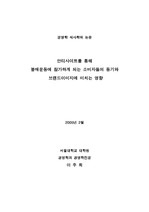1. 문제의 제기
오늘날 심화된 경쟁은 기업으로 하여금 고객의 요구를 더 정확히 파악하여 이에 최대한 부응하는데 최선을 다하도록 요구하고 있다. 이는 고객과의 관계가 예전의 양적인 규모의 확장보다는 질적으로 심화되어야 함을 의미한다. 즉, 고객 요구에 더 효과적으로 부응하여 고객이 만족하도록 하여야 함을 뜻한다. 실제로 많은 기업들은 고객 만족이란 목표를 달성하기 위하여 그들의 노력을 집중하고 있다. 따라서 기업들은 고객위주 혹은 시장위주의 개념에 기초하여 적극적인 마케팅 활동을 하면서 제품/서비스의 판매 전의 활동에 주력하는 모습을 보여 왔다. 그러나 1990년대 후반부터 우리나라 경제여건의 악화가 지속되면서 현재 제품/서비스를 구매하고 있는 고객들을 지속적으로 만족시키는 고객관계관리활동이 부각되고 있다. 기업은 신규고객을 획득, 기존고객의 개발, 가치있는 기존고객의 유지를 통하여 고객관계를 관리한다.(Wayland and Cole,1997). 고객관계를 관리한다는 것은 단순히 고객에게 초점을 맞추는 것 이상의 것으로, 올바른 고객을 선택하여 적절한 관계를 창출하고 유지하며, 이들에게 가치를 제공해 주는 것이다 (Wayland and Cole,1997). 고객에게 가치를 제공해 줌으로써 기업가치도 상승하게 된다. 신규고객의 획득에 소요되는 비용이 기존고객을 유지하는 비용보다 5배이상 많이 소요되는 것을 감안해보면(Reichheld and Sasser.1990), 기존고객을 충성고객으로 만드는 것이 기업의 수익성 측면에서도 유리하다(Jones and Sasser,1990). 이러한 고객관리를 위해 최근 온라인 커뮤니티의 발전과 함께 특정 브랜드에 대한 커뮤니티가 형성되기도 하는데, 여러 기업에서는 자사 제품의 홈페이지에 특정 브랜드의 동호회나 커뮤니티를 구성하고 공동관심사에 대한 상호의견 교환과 연대감 형성의 장소로서 활용하고 있으며, 이러한 활동을 통해 자사의 고객을 보다 직접적으로 관리할 수 있으며, 구성원들 간에 이루어지는 의견 교류나 관련 제품 정보 제공으로 브랜드에 대한 충성도와 연대감을 획득하려 하고 있다. 학계에서도 이미 기업에서 제공하는 브랜드를 바탕으로 한 커뮤니티(Brand-based community)가 타겟 브랜드에 대한 고객들의 태도와 구매행동에 어떤 영향을 미칠것인가라는 질문이 많은 연구자들에 의해 매우 중요한 연구과제로 인식되어 온 것이 사실이다.(McWilliam 2000; Muniz and O`Guinn 2001) 반면, 고객관리의 실패라고 볼 수 있는 불만족 고객들의 불매운동(boycott)과 사이버스페이스가 제공하는 익명성과 자유로운 의사표현의 가능성을 기반으로 안티사이트가 나타나면서 경영활동과 기업 브랜드 이미지에 중대한 관련이 있음에도 불구하고 소비자들이 불매운동에 참가하는 동기나 이들의 안티활동이 브랜드에 미치는 영향에 대한 연구가 거의 없는 실정이다. 특히 국내에서는 기업과 브랜드 이미지에 부정적인 영향을 미칠 수 있는 안티사이트가 급속히 증가하고 있음에도 불구하고 안티사이트 및 안티활동에 대한 실증적 연구는 거의 없는 형편이다.(허경옥,2003) 하지만 CRS(기업의 사회적 책임)에 대한 사회적 관심이나 브랜드, 기업평판에 노출되기 때문에 불매운동은 점점 더 의사결정의 중요한 요인이 되고 있다.(Jill Gabrielle Klein, N.Craig Smith, Andrew John, 2004) 그러나 기업들은 이러한 불매운동과 안티사이트의 관리가 기업의 성과에 미치는 중요성을 인식하고는 있지만, 실제로 어느 정도 영향을 미치고 있는지 또한 불매운동과 안티사이트 대한 관리를 제대로 하고 있는 기업은 찾아보기 힘들다고 해도 과언이 아니다. 따라서 불매운동과 안티사이트에 참가하게 되는 소비자들의 동기를 연구하고, 이러한 안티활동이 기업과 브랜드 이미지에 어떠한 영향을 미치고 있는가를 알아보고자 한다.
· Ahluwalia, Rohini, Robert E. Burnkrant, and H. Rao Unnava(2000), "Consumer Response to Negative Publicity; The Moderating Role of Commitment," Journal of Marketing Research, 37(May), 203-214
· Ajzen, Icek(1996), "The Social Psychology of Decision Making," In Social Psychology: Handbook of Basic Principles, E. Tory Higgens and Arie W. Kruglanski, eds. New York: Guiford Press, 297-325
· Batson, Daniel(1998), "Altruism and Prosocial Behavior," in Handbook of Social Psychology, Vol.2, Daniel T, Gibert, Susan T, Fiske, and Lindzey, eds. Boston; McGrawHill, 282-316
· Belk, Russel W.(1998), "Possessions and the Extended self," Journal of Consumer Research, 15(September), 139-68
· Bem, D.J.(1972), "Self-Perception Theory," in Advances in Experimental Social Psychology, Vol.6, L.Berkowitzm ed. NewYork: Academic Press, 1-61.
· Berger, Ida E. and Ruth M. Corbin(1992),"Perceived Consumer Effectiveness and Faith In Others as Moderators of Environmentally Responsible Behaviors,"Journal of Public Policy& Marketing, 11(Fall), 79-89.
· Blodgett, Jefferey G. and Donald H, Granbois(1992), "Towards and Integrated Conceptual Model of Consumer Complaining Behavior," Journal of Consumer Satisfaction, Dissatisfaction and Complaining Behavior, 5, 93-103
· Brixey, Elizabeth(2000), "Sweatshop Watchdog to Map Its Strategy When the New WRC Holds Its First Meeting in New York This Weekend, "Wisconsin State Journal, (April 6) A1.
· Carlsmith, J.Merrill and Alan E.Gross(1969), "Some Effects of Guilt on Compliance,"Journal of Personality and Social Psychology, 11(3), 232-39.
· Dart, Jack and Kim Freeman(1994), "Dissatisfaction response styles among Client of Professional Accounting Firm," Journal of Business Research, 29
· Dawar, Niraj and Madan M. Pillutla(2000), "Impact of Product Harm Crises on Brand Equity: The Moderating Role of Consumer Expectations," Journal of Marketing Research, 37(May), 215-26.
· Day, Ralph L. AND E. Laird Landon, Jr(1977), "Toward a Theory of Consumer Complaining Behavior", in the Journal of Marketing, vol. 52
· Day, Ralph L and Stephen B. Ash(1979), "Consumer Responses to Dissatisfaction with Durable Products", Advances in Consumer Research, vol. 6, 438-444
· Day, Klaus Grabicke, Thomas Schaetzle, and Fritz Staubach(1981), "The Hidden Aggenda of Consumer Complaining," Journal of Retailing, vol.57, pp.86-106
· Day (1984), "Modeling Choice among Alternative Response to Dissatisfaction," Advances in Customer Research,vol.11, pp. 496-499
· Dickinson, Roger and Stanley C. Hollander(1991), "Consumer Votes," Journal of Business Research, 22(4), 335-46.
· Dovidio, John F, Jane A. Pillianvin, Samuel L, Gaertner, David A. Schroeder, and Russell D. Clark III(1991), "The Arousal Cost-Reward Model and Process of Intervention: A Review of the Evidence", in Prosocial Behavior, Margaret S. Clark, ED. Newbury Park, CA: Sage Publications, 86-118
· Festinger, L.A.(1957): A Theory of Cognitive Dissonace. Stanford, CA: Stanford University Press.
· Friedman, Monroe(1985), "Consumer Boycotts In the United States, 1970-1980: Contemporary Events In Historical Perspective,"Journal of Social Issues, 47(1), 149-68

